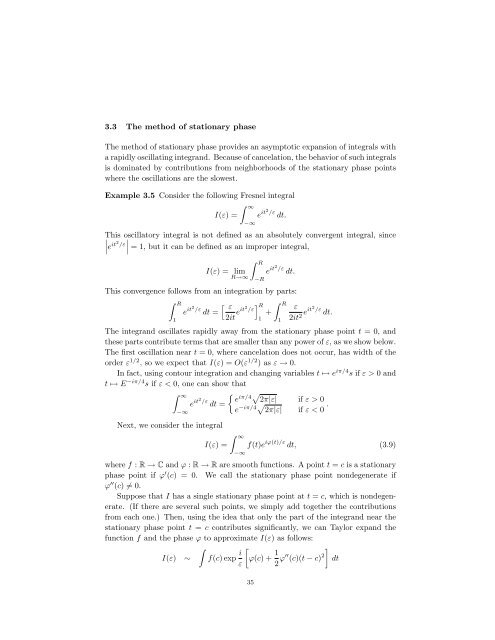Asymptotic Analysis and Singular Perturbation Theory
Asymptotic Analysis and Singular Perturbation Theory
Asymptotic Analysis and Singular Perturbation Theory
Create successful ePaper yourself
Turn your PDF publications into a flip-book with our unique Google optimized e-Paper software.
3.3 The method of stationary phase<br />
The method of stationary phase provides an asymptotic expansion of integrals with<br />
a rapidly oscillating integr<strong>and</strong>. Because of cancelation, the behavior of such integrals<br />
is dominated by contributions from neighborhoods of the stationary phase points<br />
where the oscillations are the slowest.<br />
Example 3.5 Consider the following Fresnel integral<br />
I(ε) =<br />
∞<br />
e<br />
−∞<br />
it2 /ε<br />
dt.<br />
This oscillatory integral is not defined as an absolutely convergent integral, since<br />
<br />
eit2 <br />
/ε<br />
= 1, but it can be defined as an improper integral,<br />
R<br />
I(ε) = lim e<br />
R→∞ −R<br />
it2 /ε<br />
dt.<br />
This convergence follows from an integration by parts:<br />
R<br />
e<br />
1<br />
it2 /ε<br />
dt =<br />
<br />
ε<br />
2it eit2 /ε R +<br />
1<br />
R<br />
1<br />
ε<br />
2it 2 eit2 /ε dt.<br />
The integr<strong>and</strong> oscillates rapidly away from the stationary phase point t = 0, <strong>and</strong><br />
these parts contribute terms that are smaller than any power of ε, as we show below.<br />
The first oscillation near t = 0, where cancelation does not occur, has width of the<br />
order ε 1/2 , so we expect that I(ε) = O(ε 1/2 ) as ε → 0.<br />
In fact, using contour integration <strong>and</strong> changing variables t ↦→ e iπ/4 s if ε > 0 <strong>and</strong><br />
t ↦→ E−iπ/4s if ε < 0, one can show that<br />
∞<br />
e it2 <br />
iπ/4<br />
/ε e<br />
dt =<br />
2π|ε| if ε > 0<br />
e−iπ/42π|ε| if ε < 0 .<br />
−∞<br />
Next, we consider the integral<br />
I(ε) =<br />
∞<br />
−∞<br />
f(t)e iϕ(t)/ε dt, (3.9)<br />
where f : R → C <strong>and</strong> ϕ : R → R are smooth functions. A point t = c is a stationary<br />
phase point if ϕ ′ (c) = 0. We call the stationary phase point nondegenerate if<br />
ϕ ′′ (c) = 0.<br />
Suppose that I has a single stationary phase point at t = c, which is nondegenerate.<br />
(If there are several such points, we simply add together the contributions<br />
from each one.) Then, using the idea that only the part of the integr<strong>and</strong> near the<br />
stationary phase point t = c contributes significantly, we can Taylor exp<strong>and</strong> the<br />
function f <strong>and</strong> the phase ϕ to approximate I(ε) as follows:<br />
I(ε) ∼<br />
<br />
f(c) exp i<br />
<br />
ϕ(c) +<br />
ε<br />
1<br />
2 ϕ′′ (c)(t − c) 2<br />
<br />
35<br />
dt
















